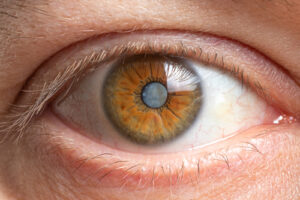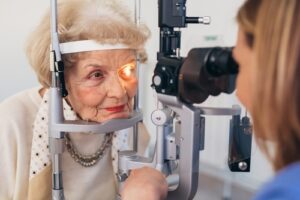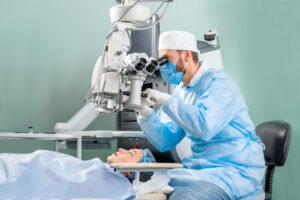Do you have cataracts? Through cataract surgery, you can restore your vision and improve your quality of life.
The procedure is considered one of the safest eye surgeries and the best treatment for cataract symptoms. To determine if it’s time for you to have cataract surgery, you’ll need to have a cataract evaluation.
Keep reading to learn how to prepare for a cataract assessment, what to expect during your cataract evaluation, and what happens during cataract surgery!

How to Prepare for Your Cataract Evaluation
If you wear contact lenses, your ophthalmologist will advise you to stop wearing them a few weeks prior to your assessment. Soft contacts shouldn’t be worn for approximately two weeks before your visit.
The period will be longer for hard contacts and may last about four weeks. Since contact lenses can change the shape of your cornea and affect essential cataract surgery measurements, they will need to be out before final measurements.
You will receive dilation drops to widen your pupils, which will affect your vision. Eye doctors also recommend you carry the following to ensure your assessment goes smoothly:
- Your glasses, if you own a pair
- A list of all your prescriptions or over-the-counter medications
- A list of the symptoms you’re experiencing
Cataract Evaluation
Plan to spend anywhere from one to two hours at your eye doctor’s office. The following are the steps taken and tests that are done as part of your cataract surgery assessment.
Eye Health and General Health Evaluation
Your eye doctor will need to know more about your eye health and general health. You’ll be asked for details like any family history of cataracts, your medical history, and any existing allergies, among other details.
Cataract Evaluation Tests
Various tests are performed to ensure cataracts are causing your vision problems. The tests also help determine the presence, position, and progression of your cataracts and if you need cataract surgery.
Experienced cataract surgeons use state-of-the-art equipment and advanced technology in order to gather the most accurate information concerning your eye. The tests done may include:
Visual Acuity
For your visual acuity test, the doctor will ask you to close one eye at a time and read letters of different sizes from a chart. This test determines how well you can see at a distance.

It can also check how much your vision has worsened since you were diagnosed with cataracts.
Slit Lamp Exam
A slit lamp is a microscope that uses a strong, narrow light beam or slit. It magnifies your eye, allowing the doctor to have a better view of your lens, iris, and cornea.
This makes it easy for your eye doctor to determine if you have a cataract and the extent of the clouding.
Retinal Exam
During a retinal exam, special drops are used to dilate or widen your pupil. Dilating your pupil is important because cataracts are often not noticeable until they have considerably advanced.
A dilated pupil gives the doctor a clearer view of the structures at the back of your eye, including the retina and optic nerve. This is crucial since eye conditions like macular degeneration and glaucoma might impact your visual outcome after cataract surgery.
Then using a slit lamp, the doctor checks what the cataract looks like and its severity.
Getting Your Questions Answered
You’ll have a one-on-one session with your eye doctor once the exams are completed. Together, you’ll discuss your test results, symptoms, lifestyle, and vision needs.
Next, your cataract surgeon will go over various treatment recommendations, including the right intraocular lens or IOL for you. Your lens choice will significantly determine your vision outcome following cataract surgery.
The cataract surgeon will guide you through these crucial decisions and help you select the options that best meet your vision goals and lifestyle.
Cataract Surgery
If your cataracts are advanced and have started to interfere with everyday activities like cooking, reading, watching TV, and driving, your doctor may suggest cataract surgery. Cataract surgery is a straightforward, same-day procedure that lasts about thirty to forty-five minutes.

You will need to arrange for someone to take you to and from the surgery center. Your cataract surgeon will start by applying numbing drops.
Thus, although you’ll be awake the entire time, the anesthetic eye drops are used to ensure your eyes are comfortable. There are different surgical techniques used to remove cataracts.
One common method is called phacoemulsification. Your cataract surgeon will then make a tiny cut in the cornea, which is the transparent layer in front of your eye.
The incision enables the surgeon to insert a tiny probe. This probe uses ultrasound waves to break up your cloudy, natural lens.
The fragments of the cataract-affected lens are removed using gentle suction while leaving the lens capsule intact. Once all the pieces are removed, your cataract surgeon inserts an artificial IOL in the empty lens capsule.
The new intraocular lens replaces the focusing power of your natural lens and is chosen during your cataract evaluation. Finally, the incision made is left to heal on its own.
Stitches are often not needed due to the small size of the cut.
After cataract surgery, you’ll be moved to the recovery room, where you’ll remain until you’re stable enough to go home.
Your eye doctor will provide care instructions before you leave. It’s important to follow these instructions to increase your chances of a successful recovery.

Get Your Cataract Evaluation at Joshi Retina
A comprehensive cataract evaluation at Joshi Retina Institute is essential for improving your vision if you have cataracts. Their exam will provide a complete picture of your eye health and enable you to learn your different options for vision improvement.
Are cataracts making it hard for you to see? Schedule a cataract evaluation at Joshi Eye Institute in Boynton Beach, FL, today to begin your journey to clear vision.



